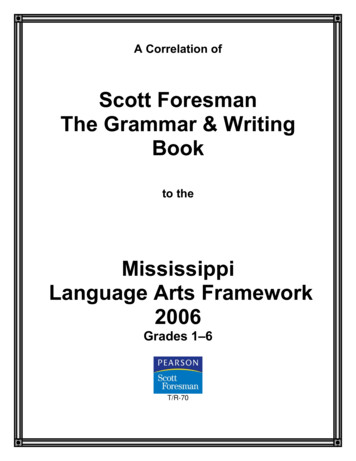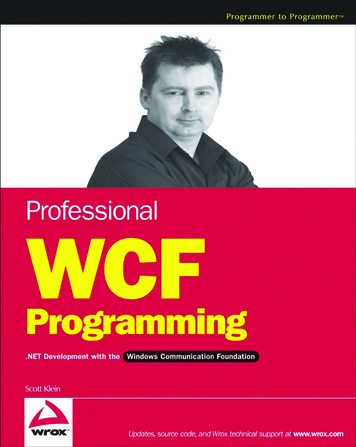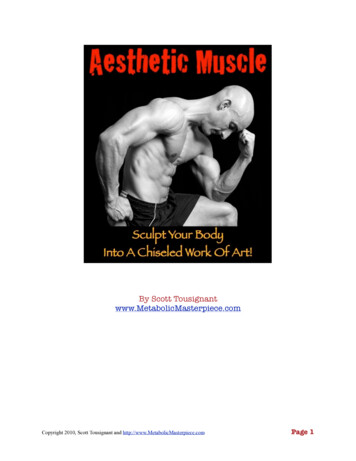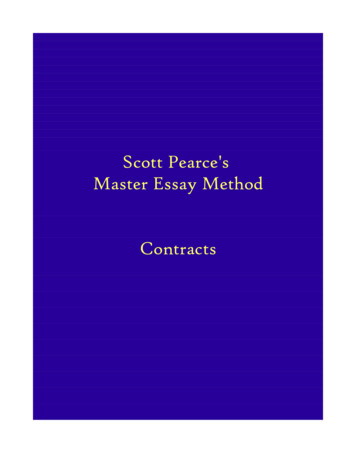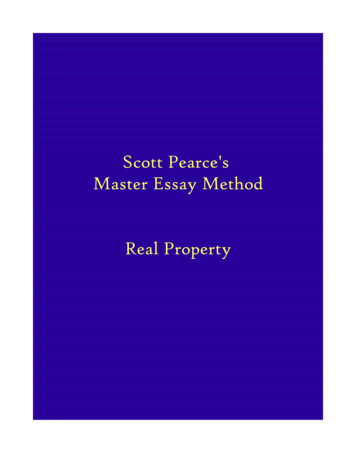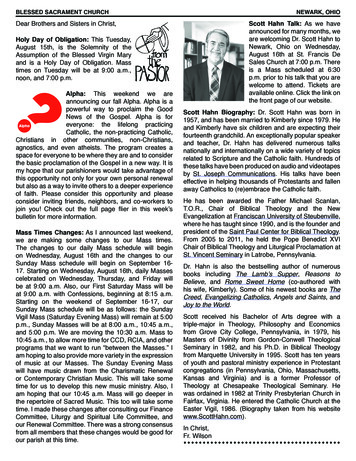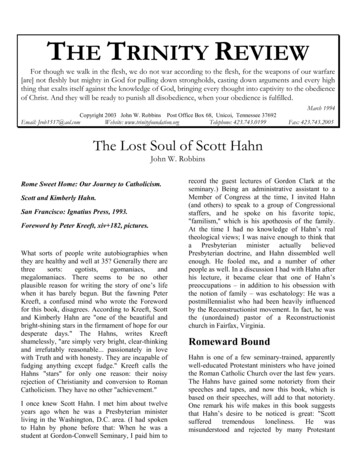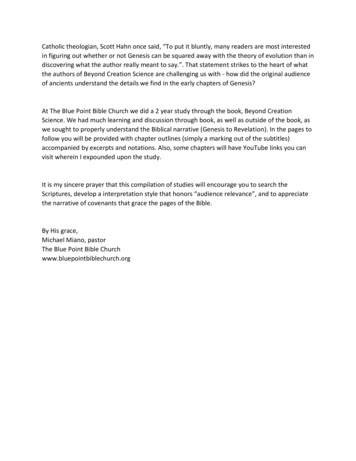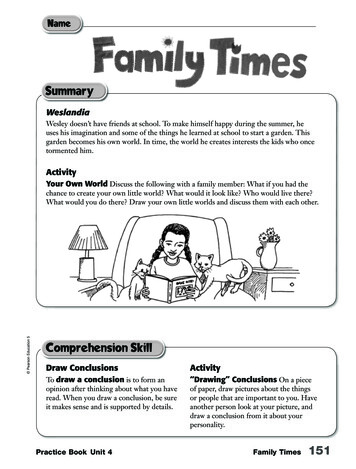
Transcription
NameSummaryWeslandiaWesley doesn’t have friends at school. To make himself happy during the summer, heuses his imagination and some of the things he learned at school to start a garden. Thisgarden becomes his own world. In time, the world he creates interests the kids who oncetormented him.ActivityYour Own World Discuss the following with a family member: What if you had the Pearson Education 5chance to create your own little world? What would it look like? Who would live there?What would you do there? Draw your own little worlds and discuss them with each other.Comprehension SkillDraw ConclusionsActivityTo draw a conclusion is to form anopinion after thinking about what you haveread. When you draw a conclusion, be sureit makes sense and is supported by details.“Drawing” Conclusions On a piecePractice Book Unit 4of paper, draw pictures about the thingsor people that are important to you. Haveanother person look at your picture, anddraw a conclusion from it about yourpersonality.Family Times151
Lesson VocabularyGrammarWords to KnowSubject and Object PronounsKnowing the meanings of these wordsis important to reading Weslandia.Practice using these words.Pronouns used in the subjectsof sentences are called subjectVocabulary Wordsobjects or objects of prepositions areblunders stupid mistakescivilization the ways of living of apeople or nationcomplex made up of a number of parts;hard to understandenvy feeling of discontent, dislike, ordesire because another person has whatyou wantfleeing running awayinspired filled with a thought orpronouns. For example: I, you, he, she,it, we, you, they. Pronouns used as directobject pronouns. For example: me,you, him, her, it, us, you, them.ActivityPronoun Paragraph Ask someonein your family to write a sentence or twothat doesn’t have any pronouns. Then,rewrite each sentence by substitutingin subject and object pronouns. Taketurns writing original sentences andrewriting them.feeling; influencerustling causing a light, soft sound ofthings gently rubbing togetherstrategy the skillful planning andmanagement of anything152Family Times Pearson Education 5Practice Tested Spelling WordsPractice Book Unit 4
WeslandiaNameDraw Conclusions A conclusion is a decision you make after thinking about the details in what you read. Often your prior knowledge can help you draw, or make, a conclusion. When you draw a conclusion, be sure it makes sense and is supported by what you have read.Directions Read the following passage. Then complete the diagram.Several factors led to the formationof cities. First, small agriculturalgroups grew larger when farmers andhunters were able to provide a steadysupply of food for more people. Also,settlers started keeping herds of animalsfor food and other purposes. Because ofthese developments there was enoughfood for everyone, so settlers had timeto learn new skills. They started makingbetter tools and finding new uses forthem. Better tools led to improvements inliving conditions. Workers built structuresto protect the community and to storefood. They traded with other groups foritems they needed. As more people livedtogether, members of the communitystarted having different responsibilitiesand social relationships changed.Eventually, these communities developeda system to govern themselves. They alsocreated a written language.Possible answers given.Detail:Detail:Detail:What you know:1. Farmers2. Settlers3. Settlers4. Goodlearnednew skills.made bettertools andfound newuses forthem. Pearson Education 5and huntersprovidedfood formorepeople.toolsmake toughjobs easier.Conclusion5.More food and better tools led toformation of cities.Home Activity Your child drew a conclusion from facts or details found in a reading passage. Tell him or hera short story about an event that happened in your life. Have your child single out two or three details fromthe story and form a conclusion about it.Practice Book Unit 4Comprehension153
WeslandiaNameVocabularyDirections Choose the word from the box that best matches each definition below. Write theword on the line.civilization1. the ways of living of a peopleor nationstrategy2. the skillful planning andmanagement of anythingrustling3. causing a light, soft sound ofthings gently rubbing togetherblunders4. stupid mistakesCheck the WordsYou rustlingstrategyDirections Choose the word from the box that best fits in thesentence. Write the word on the line shown to the left.fleeing5. In his dreams, dragons were after him and he wascomplex6. Cities are moreinspired7. The people who created the earliest forms of writing wereby a need to communicate ideas.Envy8.strategy9. To play a game or sport well, you need to form a.than tiny villages.arises when someone else gets something we wanted.10. As they hiked through the woods, they could hear the fallenrustling.leavesOn a separate sheet of paper, describe a sport you like to play, like soccer or chess. What are therules? What are the best strategies?Descriptions should include words from the vocabulary list anddetails such as the best strategies to use to win the game.Home Activity Your child identified and used vocabulary words from Weslandia. Read a short story withyour child. Have him or her point out unfamiliar words. Work together to figure out the meaning of each wordby using words that appear near it.154VocabularyPractice Book Unit 4 Pearson Education 5Write a Description
WeslandiaNameVocabulary Word Structure An ending is a letter or letters added to the end of a base word. Recognizing an ending will help you figure out the word’s meaning. The endings –s and –es can be added to singular nouns to make them plural. The endings –s,–ed, and –ing can be added to verbs to change the tense. The endings –er and –est can beadded to adjectives to use them to compare.Directions Read the following passage. Then answer the questions below.Lisa enjoyed camping with her brotherand parents every autumn. In a wayshe felt they were fleeing civilization andtheir complex city life. She had noticedthat life in the city often makes peopleanxious. She always felt happier whilehiking through the woods and sleepingunder the stars. There was no one to envybecause the beauty of nature surroundedthem. Even the blunders they made turnedinto games to play. Once they hiked downthe wrong trail and got lost. Instead ofworrying, they worked together to find thequickest way back. When she returned tothe city, Lisa felt inspired by the beautyshe had enjoyed.Possible answers given.1. In the word fleeing, how does the –ing change the meaning of the root word?It changes the tense of the verb.2. What is the difference between the –s in blunders and the –s in makes?The first –s makes a noun plural, while the second –s puts averb in the present tense.3. How does the –er change the meaning of the root in happier? Pearson Education 5It makes a comparison.4. What does the –ed in hiked do to the meaning of the root word?It puts the verb into the past tense.5. Change some of the endings in this sentence to put the verbs in the past tense: “Lisa calls out toher family, and then walks down the trail to meet them.”Lisa called out to her family, and then walked down the trail tomeet them.Home Activity Your child identified and used endings added to base words, such as –s, –ed, –ing, and–est. Read a newspaper or magazine article with your child. Change the endings of some of the words anddiscuss with him or her how the sentences’ meanings change.Practice Book Unit 4Vocabulary155
WeslandiaNameMain Idea and DetailsDirections Read the following passage. Then answer the questions below.Did you and your friends ever make upyour own language? Young childrenoften make up a language that otherpeople cannot understand. However, somepeople have created complete languagesfor everyone to use. The best known andmost successful of these languages isEsperanto (es-puh-RAHN-toe).Around 1887, a Polish doctor namedL.L. Zamenhof constructed Esperanto. Hethought that if everyone learned Esperanto,it wouldn’t matter what language a personspoke at home. Everyone would speak andwrite in Esperanto. His goal was to makeit easier to settle disagreements and worldconflicts.To test his language, Zamenhof wroteEsperanto versions of many famous texts.Since then, more than 30,000 books havebeen published in Esperanto. Esperantois still used today, but has not achievedZamenhof’s goal.Possible answers given.1. In a few words, what is the passage about?It is about Esperanto as a common language.2. What is the most important or main idea of the passage?Esperanto was created to be a common language understood byeverybody.3. What is one important detail that tells more about the main idea?L.L. Zamenhof created Esperanto in 1887.He thought it could be used to settle disagreements and worldconflicts.5. Write a summary of the passage in one sentence.Esperanto achieved some success as a common language butisn’t widely used.Home Activity Your child identified the main idea and supporting details of a nonfiction passage. Read amagazine article with your child. Work together to identify the main idea and supporting details of the article,then write a short summary.156ComprehensionPractice Book Unit 4 Pearson Education 54. What is another detail about the main idea?
WeslandiaNameDraw Conclusions A conclusion is a decision you make after thinking about the details in what you read. Often your prior knowledge can help you draw, or make, a conclusion. When you draw a conclusion, be sure it makes sense and is supported by what you have read.Directions Read the following passage. Then answer the questions below.When Kyoung first arrived in theUnited States, he saw all the tallbuildings and cars and people. It lookedjust like he’d seen in the movies. Everyoneand everything moved very quickly. Therealso was so much more of everything thanin his village in his old country. It wasn’tuntil he got to his new home in Maryvillethat time seemed to slow down.At school, the other students didn’t talkto him much because they had troublepronouncing his name. His teachersuggested they call him “Bill.” So Billbecame his nickname. The other studentstalked to him more, asking questionsabout his country or what he had gonethrough before he came to the UnitedStates. He tried to explain, but it wasnot always easy. The cultures were verydifferent and he was still learning English.Nevertheless, he told them a little eachtime they asked.Possible answers given.1. How do you think Kyoung felt when he first reached the U.S.?He may have felt excited, and a little frightened and homesick.2. What parts of the text helped you reach the conclusion you described above?The passage describes how the U.S. seems like a movie, and howeverything is big and fast-moving.3. What things that you already knew helped you reach the conclusion you described above? Pearson Education 5Big cities are often amazing to people from the countryside.4. Do you think Kyoung using the nickname “Bill” was a good idea? Why or why not?Yes; It made students more willing to try talking with him.5. How do you think Kyoung felt when other students asked him about his past? Is your conclusionbased on the passage, on your own experience, or both?Happy to be asked; I based my answer on the text and on how Iwould feel if I were Kyoung.Home Activity Your child drew conclusions from the details of a brief story. Read an article or story withyour child about a faraway place. Ask him or her questions about how someone from there of your child’sage might adapt to life in the United States.Practice Book Unit 4Comprehension157
WeslandiaNameDraw Conclusions A conclusion is a decision you make after thinking about the details of what you read. Often your prior knowledge can help you draw, or make, a conclusion. When you draw a conclusion, be sure it makes sense and is supported by what you have read.Directions Read the following passage. Then complete the diagram.People have played games throughouthistory. There are all kinds ofgames—card games, board games, sportsgames, children’s games, and problemsolving games. People have inventedgames that can be played by one person,a few people, or by whole teams. Gamesgive people a chance to challenge theirminds and bodies. They also give peoplethe thrill of winning. Best of all, gamesare fun.Possible answers given.Detail:Detail:Detail:2. There aremany different3. Games challengepeople’s mindsthroughoutrecordedhistory.kinds ofgames.and bodies.I likeplayinggames.4. Pearson Education 51. People haveplayed gamesWhat you know:Conclusion5. People everywhere loveto play games.Home Activity Your child drew conclusions from facts or details found in a reading passage about games.Read a story or an article with your child. Work with him or her to draw conclusions from the details in it.158ComprehensionPractice Book Unit 4
WeslandiaNameInstruction Manual Following directions involves doing or making something. Directions are usually numbered. Read all the directions before starting to act on the first direction given. Read the first direction, do what it says to do, then proceed to the next step. Try to visualize the purpose or result of the process.Directions Read these directions. Then answer the questions.How to Make Crystals1. Gather the materials you willneed. They are: a small amount ofEpsom salts, water, a sponge, anda shallow dish.2. Boil water. Remove from heat.Add about 1/4 cup of Epsom saltsto about 1/2 cup of boiling water.Stir until the salts dissolve.3. Put a sponge in a shallow dish.Pour the liquid over the sponge.(The crystals will be easier to seeon a sponge.) Only pour in enoughof the mixture to cover the bottomof the dish.4. Put the glass dish in a secure spotin the sun. Soon the water willevaporate and crystals will grow.1. You and a friend have decided to make crystals. What would you do first? Explain.Read all the dir
Pearson Education 5 Practice Book Unit 4 Family Times 151 Name Draw Conclusions To draw a conclusion is to form an opinion after thinking about what you have read .
